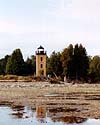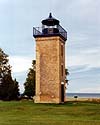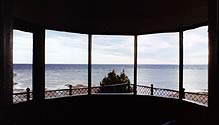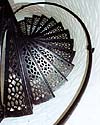 |
 |
 |
 |
| Point Peninsula Lighthouse | Seeing The Light |
|
|
|
|
Historical
Information In order to warn mariners bound for the rapidly growing harbor industries in Manistique and Escanaba of the dangerous shoals close by the shipping lanes, the Lighthouse Board petitioned Congress for the construction of a lighthouse at the location known as Peninsula Point at the peninsula's southernmost end. Congress responded favorably to the request on July 20, 1864, with the appropriation of the necessary funds for the project. Work at Peninsula Point began the following year, and progressed rapidly, allowing the light to be displayed during that same shipping season.
Ira Buck was appointed as the station's first keeper, and he remained at the station until he resigned from lighthouse service in 1865. Captain James D. Armstrong was appointed keeper in 1889, and remained at the Point until 1925, two years after the station was automated through the installation of an acetylene lamp equipped with a sun valve. With the construction of the Minneapolis Shoal Light in 1934, the old light at Peninsula Point had outlived its' useful life, and thus its' light was extinguished in 1936. The following year, the United States Forest Service was granted custodianship. The Forest Service repaired the buildings, and the Civilian Conservation Corps constructed public picnic grounds on the property.
The Forest Service continues to maintain the tower and the grounds as a public picnic area. All glass and doors have been removed from the tower, and the public can climb the tower and enjoy the view from the lantern room. Keepers of this
Light According to the brochure published by the USDA Forest Service, Peninsula Point is a fall gathering place for Monarch butterflies, who congregate to feed-up in preparation for their crossing of Lake Michigan to the to Door Peninsula. While we only saw a few butterflies on our visit to the point, we certainly saw a lot of butterfly watchers, as approximately fifty people with butterfly bumper stickers, butterfly-related personalized license plates and butterfly sweatshirts were congregating in the picnic grounds. As we carried our camera equipment to the lighthouse, we received a friendly welcome from one elderly lady, who we turned to her silver-haired companion and loudly commented "just what we need - more lighthouse photographers." Not to be perturbed, we walked the grounds, climbed the tower, and enjoyed the vista from the windowless lantern room. The Forest Service has done a good job of maintaining the lonely tower, with all metalwork painted with a freshly applied coat of glossy black paint.
Reference Sources |
This page last modified 01/24/2002